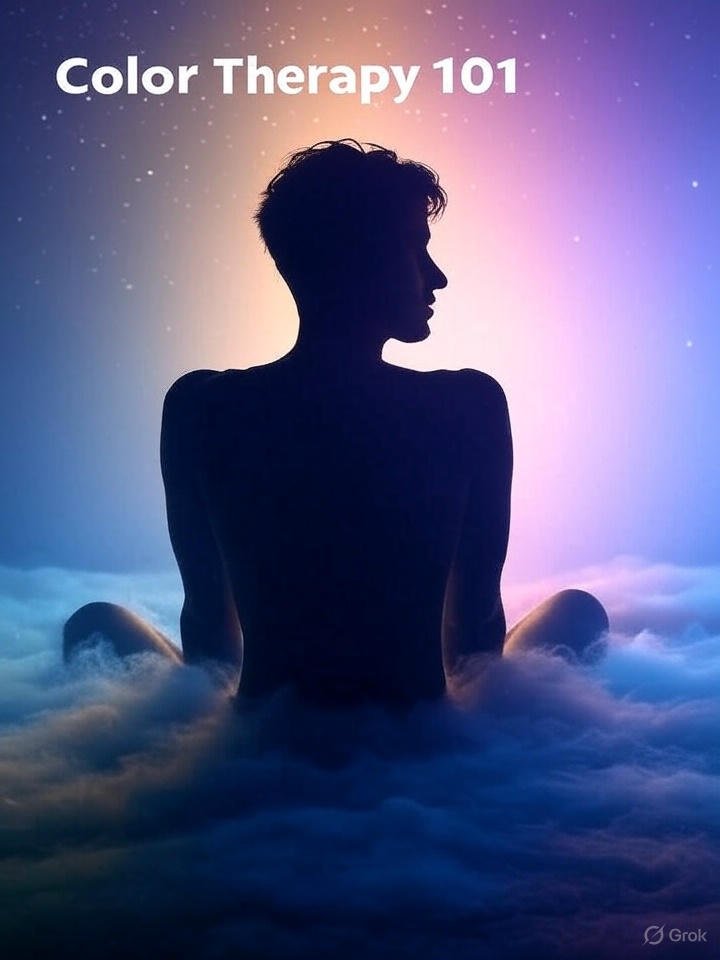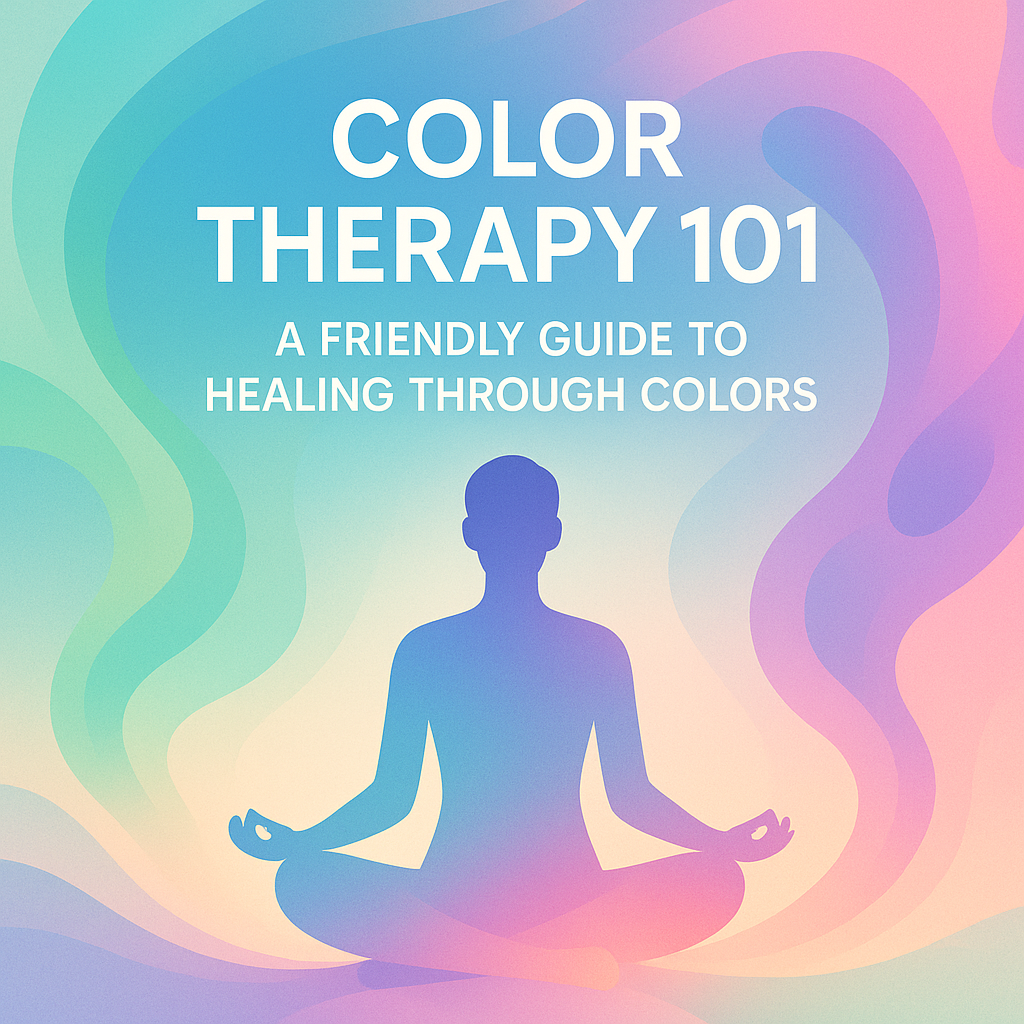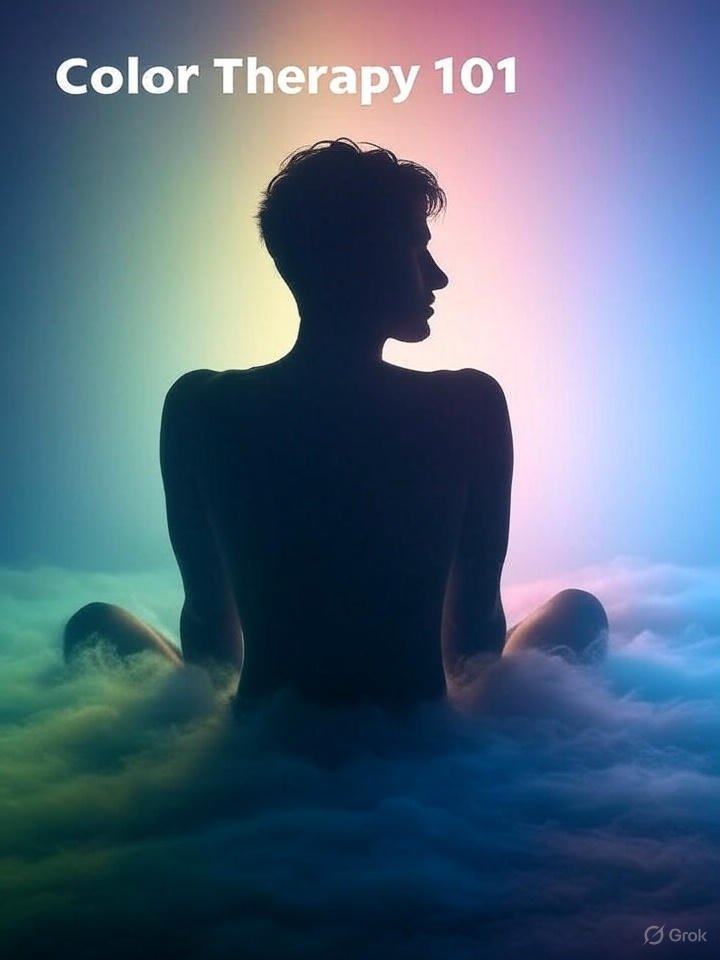When I first stumbled upon the idea of using colors as a form of healing, I was honestly skeptical. But the more I explored, the more I realized just how much our environment and its colors shape the way we feel and act. That’s why I decided to share my journey and insights with you through this guide, “Color Therapy 101: A Friendly Guide to Healing Through Colors.” It’s not just about pretty hues or interior design tips — it’s about tapping into the quiet power of color to bring more balance and calm into our daily lives.

Table of Contents
I remember feeling overwhelmed and exhausted at the end of long workdays, and that’s when I noticed how certain colors in my surroundings seemed to either soothe me or drain me. Soft blues and greens brought a sense of calm and peace, while bright reds or yellows seemed to either energize me or make me feel tense if I was already stressed. It was fascinating to see how color therapy — something so simple and natural — could make such a noticeable difference.
As I started digging deeper, I learned that color therapy, or chromotherapy, has actually been around for centuries. People across different cultures have long believed that colors hold unique energies that can help heal and balance the mind and body. Today, it’s becoming more popular as part of holistic wellness practices. And honestly, it’s easy to see why — unlike some wellness trends that require fancy gadgets or expensive treatments, color therapy is incredibly accessible. You don’t need special equipment; you just need an open mind and a willingness to experiment.
In this guide, I want to share not only the basics of how color therapy works but also how you can easily use it in your own life. We’ll go through the emotional impact of colors like soothing blues, energizing reds, joyful yellows, and balancing greens. I’ll share some practical ways I’ve used color therapy myself — from picking out calming paint colors for my bedroom to choosing outfits that help me feel more grounded and confident.
But most importantly, I want this to feel like a conversation, not a lecture. My goal with “Color Therapy 101: A Friendly Guide to Healing Through Colors” is to give you a down-to-earth look at how color therapy can bring more harmony and happiness to your days. It’s about making simple changes — like swapping out a harsh overhead light for a soft amber glow, or sitting with a gentle green visualization during a stressful moment — and seeing how those changes ripple through your mood and energy.
So, whether you’re completely new to color therapy or just curious about how it might work for you, I hope this guide inspires you to see color in a whole new way. Let’s explore the colors that make life feel brighter, calmer, and more balanced — together.
What is Color Therapy?
Before I dove into the world of color therapy, I had no idea that colors could be more than just a part of fashion or interior design. But as I explored deeper, I realized that color therapy — also known as chromotherapy — is much more than just pretty shades. It’s a simple yet powerful practice that taps into how different colors can influence our emotions, energy, and even our overall well-being.
At its core, color therapy is based on the idea that colors each carry their own unique vibrations and energies. Think of it like this: when you’re surrounded by certain colors, your mood can shift. Soft blues can make you feel calm, while warm reds can bring a burst of energy. It’s almost like colors speak to our subconscious in ways we don’t always notice. Color therapy harnesses this natural connection to help balance our body and mind, creating a more harmonious and peaceful state.
When I first started learning about it, I was surprised to find out that color therapy isn’t some new-age idea — it actually has deep historical and cultural roots. Many ancient cultures believed that colors held healing powers. For example, the ancient Egyptians used colored stones and sunlight to promote physical and emotional healing. In India, color is a big part of Ayurveda, the ancient holistic system of medicine, where different colors are linked to the body’s energy centers, or chakras. Even in traditional Chinese medicine, the idea of balancing colors and elements to maintain health has been around for centuries.
It’s fascinating to see how these traditions recognized the power of color long before modern science started to catch up. And while today’s world is full of screens and artificial lighting, the essence of color therapy remains the same: using the colors around us to create a sense of balance and well-being.
In modern times, color therapy has found a place in holistic health and wellness practices. Many spas and wellness centers use colored lights or themed rooms to help clients relax or re-energize. Interior designers are also tapping into the emotional power of color to create spaces that soothe the mind and uplift the spirit. Even in my own home, I’ve noticed how swapping out a harsh white light for a warm amber bulb can make my evenings feel so much more peaceful.
The beauty of color therapy is that it’s flexible and accessible — you don’t need to spend a lot of money or have special equipment to give it a try. It’s about paying attention to how colors make you feel and using that awareness to create a more balanced, harmonious life. Whether you’re painting a room, picking out a shirt to wear, or simply taking a moment to sit with a calming color visualization, color therapy offers a gentle, natural way to boost your mood and support your well-being.

The Science Behind Color Therapy
I’ll admit, when I first heard about color therapy, I wondered if there was any real science behind it. Could colors really do more than just look nice? But as I kept reading and experimenting, I found there’s actually quite a bit of fascinating research and psychology to back it up.
The truth is, our brains and bodies respond to colors in ways we don’t always notice. Have you ever walked into a room with soft, warm lighting and immediately felt more at ease? Or maybe seen a bright red sign and felt a sudden jolt of energy? That’s the power of color at work. It turns out that our eyes and brains process colors through the visual cortex, and from there, colors can trigger emotional and even physical responses.
Basic color psychology suggests that different colors can evoke different moods and feelings. For instance, blues and greens are often linked to calmness and relaxation — it’s probably why I find myself reaching for my favorite blue hoodie when I’m stressed! On the other hand, reds and oranges can make us feel more alert and energized, which is great when you need a little boost during the afternoon slump.
There’s also research that shows how colors can affect things like heart rate and even our perception of temperature. I remember reading about a study that found people in blue-lit rooms reported feeling cooler, while those in red-lit rooms actually felt warmer — even though the air temperature stayed the same. It’s amazing how much our minds and bodies respond to something as simple as color.
I’ve also seen how experts use this knowledge in practical ways. For example, some hospitals have started using calming colors like pale greens and soft blues in patient rooms to help reduce anxiety and stress. In the world of marketing, color psychology is a big deal too — there’s a reason why certain brands use bright reds to catch our attention or calming greens to build trust. It’s all about how our brains react to these colors on a subconscious level.
What I’ve come to realize is that color therapy isn’t just a feel-good trend — it’s rooted in how we’re wired as human beings. Our ancestors probably didn’t have scientific studies to prove it, but they understood that the colors in our surroundings can change how we feel. And today, there’s growing evidence from both psychology and biology that supports this.
Of course, color therapy isn’t meant to replace medical treatment or therapy, but it’s a wonderful tool to add to your wellness toolkit. From what I’ve learned and tried myself, it’s a way to tune in to your body’s natural rhythms and create spaces that nurture your mood and energy. Whether you’re using color to create a peaceful corner in your home or just paying attention to how your favorite colors make you feel, there’s a quiet magic in letting color become part of your journey to better well-being.

Common Colors and Their Effects
As I started experimenting with color therapy in my own life, I noticed that certain colors had very specific effects on my mood and energy. It was like each color carried its own unique personality — and learning to work with them felt like meeting a group of friends who all had something different to offer.
Let’s start with blue. It quickly became my go-to color when I needed to unwind. Whether it was a soft blue throw blanket or a calming blue candle, this color always seemed to soothe my mind. I learned that blue is often associated with feelings of calm and serenity, which makes sense because I always feel more at ease in a blue room. It’s the perfect color to help quiet a racing mind.
Green is another favorite of mine, especially on days when I feel off balance. There’s something about green that feels so natural and refreshing — maybe because it reminds me of the outdoors and the calm of a forest. Green is often linked to balance and harmony, which is exactly how it feels for me. I try to keep a few green plants around my workspace; they really help me feel more centered.
Yellow is the color I turn to when I need a little sunshine in my soul. Even on the gloomiest days, a pop of yellow in my kitchen or a bright yellow scarf seems to lift my mood instantly. It’s no wonder that yellow is associated with joy, energy, and optimism. Just a hint of it can make a dull day feel brighter.
Then there’s red, which I’ve learned to use carefully. Red is bold and energizing — it’s a color that can really get your blood pumping! I find it great for times when I need a boost of confidence or motivation. Wearing a red shirt before a big meeting makes me feel more assertive and ready to take on the world.
Orange feels like the life of the party. It’s warm and inviting, a color that brings a sense of excitement and enthusiasm. I like to use orange accents in my home when I want to create a cozy and lively vibe.
Purple has always felt a bit magical to me. There’s something about its deep, rich tones that feels creative and even a little spiritual. Purple is often linked to creativity and imagination — I find it really helpful when I’m writing or brainstorming new ideas.
Finally, pink is my comfort color. It’s soft, gentle, and always seems to wrap me in a sense of compassion and calm. I’ve used it in my bedroom to create a peaceful and nurturing atmosphere.
What I love most about these colors is that they’re so easy to bring into your life. You don’t need to paint an entire room or buy a whole new wardrobe — sometimes it’s as simple as adding a colorful pillow or wearing a favorite scarf. Each color is like a little helper, waiting to lend you the energy or calm you need most.
How to Use Color Therapy at Home
One of the things I’ve loved about exploring color therapy is how it can be woven into daily life in such simple, natural ways. You don’t need to spend a fortune or do anything complicated — it’s about being more mindful of the colors you surround yourself with and how they make you feel.
For me, it started with small changes around the house. I swapped out my plain white bedding for a set in soft blue and green tones, and it instantly made my bedroom feel more peaceful. Even something as simple as changing the color of your pillowcases or adding a cozy throw blanket in a calming color can make a noticeable difference in your mood.
Another thing I’ve found helpful is using color in my wardrobe. On days when I feel a little sluggish, I’ll reach for a bright yellow scarf or a bold red shirt to give myself an instant energy boost. It’s almost like giving myself a pep talk through my clothes! On the flip side, if I’m feeling anxious or overwhelmed, I gravitate toward softer colors like pale pinks or greens to help me feel more centered.
Lighting can also play a huge role in color therapy. I swapped out the bright white bulbs in my living room for warmer, amber-toned lights, and it made the space feel so much cozier and more inviting. If you want to take it a step further, you can even try colored light bulbs or lamps. Soft blue or purple lights in the evening can be especially calming.
Another practice I’ve been playing with is color meditation. It’s really simple — I just close my eyes and imagine being surrounded by a particular color that I feel drawn to. For example, if I’m feeling stressed, I might picture a gentle green light wrapping around me like a cozy blanket. Even just a few minutes of this can help me feel more relaxed and balanced.
Plants and artwork are other easy ways to bring color therapy into your home. I’ve added a few leafy green plants to my workspace, and not only do they look beautiful, but they also make me feel more grounded and refreshed. I’ve also hung up a couple of abstract paintings in calming blues and greens in my hallway, which always make me smile when I walk by.
The best part about color therapy is that it’s so personal. What works for me might be different for you, and that’s perfectly fine. The key is to experiment and notice how different colors make you feel. Whether it’s through your clothes, your home décor, or even just a quick visualization exercise, color therapy is all about tuning in to the quiet power of color and using it to create a space — and a mindset — that supports your well-being.
Tips for Getting Started with Color Therapy
If you’re curious about color therapy but not sure where to begin, don’t worry — it’s easier than you might think. When I first started, I kept things simple and focused on how each color made me feel. Here are a few beginner-friendly tips that helped me find my way:
1. Pay attention to how colors make you feel.
One of the first things I did was take a look around my home and notice which colors felt comforting and which felt overwhelming. It’s amazing how much of a difference it can make when you’re mindful of the colors around you. Even little changes, like adding a colorful pillow or swapping out a lampshade, can have a big impact on your mood.
2. Start small.
You don’t have to redecorate your whole house or invest in fancy lighting to try color therapy. I started by picking out a couple of small items in colors I loved — a soft green throw blanket, a cheerful yellow mug — and noticed how they made me feel throughout the day.
3. Use color in your wardrobe.
Clothing is such an easy way to bring color therapy into your life. I found that on days when I needed a little boost of confidence, wearing something red or orange really did the trick. And when I wanted to feel more relaxed, I’d reach for my soft blue hoodie. Try playing around with different colors and see how they influence your mood.
4. Try color meditation or visualization.
This was a game-changer for me! Just taking a few minutes to close my eyes and imagine myself surrounded by a color I needed — like calming green or peaceful blue — helped me feel more grounded and balanced. It’s a great tool to have in your self-care toolkit.
5. Be patient and have fun with it.
The biggest thing I learned is that color therapy is personal. It’s not about rules or strict guidelines — it’s about tuning in to what works for you. Some colors might feel amazing in your living room, while others might be better suited for your wardrobe or a quiet meditation space. Let it be a playful and creative process!
Over time, I found that color therapy became less of a “therapy” and more of a gentle way to support myself. The more I paid attention to how colors made me feel, the more I realized how powerful this simple practice can be. So take your time, trust your instincts, and enjoy the colorful journey ahead!
Conclusion
As I’ve explored color therapy in my own life, I’ve come to see it as a quiet, gentle form of self-care — one that’s always been there, waiting to be noticed. From the bright reds that spark my energy to the calming blues that soothe my stress, each color seems to have a unique way of supporting me, even on the busiest days.
“Color Therapy 101: A Friendly Guide to Healing Through Colors” has been my way of sharing what I’ve learned and experienced. The most beautiful part of color therapy is how personal it is — there’s no one-size-fits-all formula. What feels energizing to me might feel overwhelming to someone else, and that’s perfectly okay. The key is to be open and curious about how colors make you feel and to use that awareness as a gentle tool to support your mood and well-being.
As you start to experiment with color therapy, remember that it’s all about listening to your own reactions and finding what works for you. Maybe you’ll find a favorite color that calms you instantly, or maybe you’ll discover a new appreciation for how color can transform your environment. There’s no rush and no need to make huge changes overnight — it’s all about making small, meaningful adjustments that make your day-to-day life a little brighter and more balanced.
For me, color therapy has become a quiet companion, helping me create spaces and moments that feel good to me. I hope this guide has inspired you to explore how color can support your own journey toward balance and well-being. So go ahead — open your eyes to the rainbow of possibilities around you and let color be a friend in your healing journey.
Final Thoughts and Next Steps
Now that you have a solid understanding of “Color Therapy 101: A Friendly Guide to Healing Through Colors,” I hope you’re feeling inspired to bring a little more color into your daily life — and to see it as more than just decoration. To me, it’s become a small but powerful way to support my mood, boost my energy, and find a little more peace in my day.
If you’re just starting out, remember to trust your instincts. Your home, your wardrobe, even your daily rituals — they’re all blank canvases for you to paint with colors that make you feel good. Take a moment to notice how you feel when you’re surrounded by different colors, and let those feelings guide you. You don’t need to follow any rigid rules — your own reactions are the best teacher.
Personally, I’ve found that color therapy has added a layer of mindfulness to my life that I didn’t even know I was missing. Even something as simple as choosing a color to wear in the morning has become a small act of self-care, a way of checking in with how I’m feeling and what I need.
If you want to dive deeper, consider learning about the chakras or exploring color therapy tools like colored lights, meditation exercises, or guided visualizations. But even if you keep it simple — a pop of your favorite color in your living room, a bright scarf on a dreary day — you’re already on your way.
So, go ahead: embrace the power of color, trust your instincts, and let the magic of color therapy become part of your own healing journey. You might be surprised at how these small, colorful shifts can brighten your day and bring a little more balance to your life.
🌈 Ready to explore the magic of colors?
Try out color therapy for yourself and see how these small shifts can bring more balance and brightness to your everyday life! Share your favorite color and how it makes you feel — let’s inspire each other to create more colorful, mindful spaces. 💛✨

What exactly is color therapy?
Color therapy, also known as chromotherapy, is a practice that uses different colors to influence our mood and energy. It’s based on the idea that colors have unique vibrations that can promote emotional and physical healing — like how blue can feel calming or yellow can feel energizing.
How does color therapy actually work?
In my experience, color therapy taps into the way our brains and bodies respond to color. Different colors can trigger different feelings and reactions — like how a cozy green room can help you feel more balanced, or a splash of red can make you feel more awake and confident. It’s all about using color to support your mood and well-being.
Is there any science behind color therapy?
Yes, there’s some interesting research that shows how colors can affect things like heart rate, mood, and even our sense of warmth or coolness. While color therapy isn’t a replacement for medical treatment, it’s supported by color psychology and even used in some modern healthcare settings to create calming environments.
How can I start using color therapy at home?
I found that the easiest way to start is to pay attention to the colors that make you feel good. Try adding small touches — like a soft blue throw blanket, a bright yellow mug, or a green plant — and see how they make you feel throughout the day. You can also try color meditation or choose clothes that match your mood!
Can color therapy help with stress and anxiety?
Personally, I’ve found that it can be really helpful for creating a calm and relaxing space. Using calming colors like soft greens and blues in your home or workspace can make a big difference when you’re feeling stressed. While it’s not a substitute for therapy, it’s a lovely, natural way to support your mental health.

